
October 2010
Assemblies and Marches

Assembly of 900 students at Paris X University in Nanterre votes on October 22 to strike and blockade
the campus. (Photo: Michel Euler/AP)
Over the course of two weeks in France during the struggle against right-wing president Nicolas Sarkozy’s pension “reform” law, The Internationalist was present at a number of student assemblies, blockades and marches at different universities in Paris, including Tolbiac and the Sorbonne (Paris I), Jussieu (Paris VI), Saint-Denis (Paris VIII) and Nanterre (Paris X). Following are notes on a couple of those occasions.
Monday morning, October 25, blockade and student assembly at Paris X University at Nanterre
Arrived at the University at 7:30 a.m. where people were told to come for the blockade that had been voted on at a general assembly of hundreds of students last Friday, October 22. It was still dark, and a couple dozen activists were standing around the entrances to three main buildings that had been blocked with flimsy barricades of metal screens and trash cans. On a couple of occasions, a student would arrive and start screaming about wanting to get in to attend classes, but obviously trying to start a physical incident in order to claim they were attacked. (Obvious because there were no students and teachers or classes going on inside the building, which was deserted except for campus security.) The strike activists reacted calmly and eventually the would-be strikebreakers left. However, there were only a few activists at each entrance and the organization was haphazard, with little real preparation to defend the barricade.
During the morning, The Internationalist spoke with some of the activists. One was from a Communist Party family and was a member of the CP youth until a couple of years ago when he quit because they wouldn’t let members discuss anything but the line for youth. They weren’t supposed to have opinions on broader issues. He is concerned that the strike movement and other recent protests have just been about resistance, and didn’t present a positive vision of what people are fighting for, a reflection of the reformist politics of the leaders. A second activist, Is., was formerly a member of the LCR (Ligue Communiste Révolutionnaire) who dropped out when it dissolved and became the NPA (Nouveau Parti Anticapitaliste). He is now active in the UNEF (National Federation of French Students), which effectively has two branches on campus – one affiliated with the national UNEF, which is linked with the Socialist Party, and the other of the NPA and other “far left” groups. The two UNEFs cooperate against the right, but otherwise act pretty much separately.
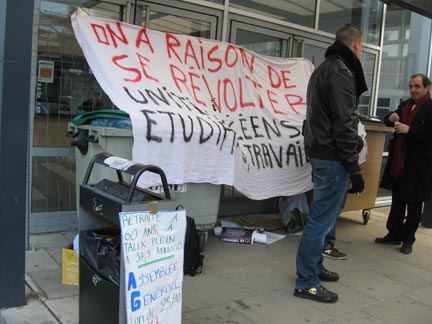 Blocked door at
Nanterre. Banner reads: “It’s
Right to Revolt. Students, Lycéens, Workers Unite” (Internationalist
photo)
Blocked door at
Nanterre. Banner reads: “It’s
Right to Revolt. Students, Lycéens, Workers Unite” (Internationalist
photo)
Part of the reason the core of activists is somewhat limited, Is. explained, is simple fear of repression, as occurred three years ago during protests over the LRU, a law introduced by President Sarkozy in favor of “university autonomy” but actually for privatizing public higher education. Under the law, companies would finance certain programs in “public-private partnerships.” The law was voted on during the summer, when there was no one on campus. After school started in the fall, there were attempts at campus occupations. On 13 November 2007, as 250 or so students were blockading the main building at Nanterre, vanloads of CRS riot police and gendarmes showed up and started viciously beating demonstrators. You can see a video of this here. A number of students were subsequently expelled. Following that incident a certain demoralization set in.
Is. is in favor of a general strike to demand withdrawal of the pension “reform” law. Last weekend, he and a carload of students from Nanterre went out to the Grandpuits oil refinery, about 100 km away, to speak with the strikers there. Even though the local prefect requisitioned strikers to load tank trucks in the fuel depot, the refinery itself is still struck. However, so far only some railroad workers and truck drivers have joined them. It’s more difficult these days to organize a general strike, he noted, because of the tremendous expansion of temporary jobs and limited term job contracts (CDDs), which typically run for just under three months.
A big issue here is the division between secondary school students (lycéens) and university students (étudiants), although it seems to be the elephant in the room that nobody talks about. Nanterre, where the campus of Paris X is located, is in one of the working-class suburbs ringing the capital, with a Communist Party mayor. Many of the high school students are black or North African and live in impoverished housing projects. Nanterre university and Nanterre city are like two different universes which barely touch, we were told; in fact, they are divided by the tracks of the RER suburban railway. We asked if the students at Paris X had come to the aid of the high school students who had faced massive repression as they repeatedly shut down the Lycée Joliot-Curie from October 12 to 21.
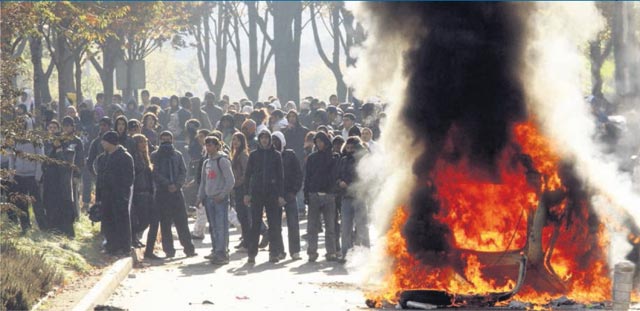
Hundreds
of
high school studentsoutside Lycée Joliot-Curie in
Nanterre face off against police,
October 18. Free all those arrested
during the protests, drop all charges! (Photo:
Thomas
Sansom/AFP)
The bourgeois press had run sensationalist
coverage of
“riots” in Nanterre, with photos of smashed bus shelters and burning
cars, blaming
everything on mobs of hundreds of “casseurs,”
or “smashers.” Le Parisien (19
October) claimed that a crowd of 300 casseurs
confronted teachers, parents, local elected officials and gendarmes
mobiles
(riot police) at the Joliot-Curie. This was a total distortion. The
teachers at
Joliot-Curie passed a motion on October 15 to “vigorously denounce the
presence
of the police and the way they intervened,” barging into the school at
7 a.m.,
firing their Flash-Ball weapons at students and using tear gas “in a
situation
that didn’t call for it, risking injury to the youths” (see SUD
Education 92
web site). And on October 18, a general assembly of teachers in
Département 92
(including Nanterre) passed a motion “denounc(ing) the massive police
presence
… targeting certain schools in the department, among them Joliot-Curie
in
Nanterre.” (The motion said that “if force and jailings are used against the lycéens, we will be at their
side, so that their rights are respected.” It
did not, however, raise the basic demand for freeing all those
arrested.)
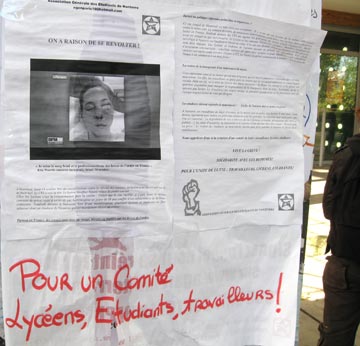 Below leaflet with
picture of Geoffrey Tidjani, the lycéen shot in face with
FlashBall gun by police in Montreuil, is written: “For a Committee of Lycéens, Students and Workers!” (Internationalist photo)
Below leaflet with
picture of Geoffrey Tidjani, the lycéen shot in face with
FlashBall gun by police in Montreuil, is written: “For a Committee of Lycéens, Students and Workers!” (Internationalist photo)
When asked whether Nanterre university students had come to the aid of the Nanterre lycéens, students mentioned an incident at a general assembly the week before in which a scuffle ensued when some lycéens showed up on campus looking for a room to meet. Whatever the specifics, the high school students were being persecuted by the police, who had apparently closed off their meeting place. In any case, the overwhelmingly white university students should have demonstratively come to the aid of the youth of immigrant origin who were being blamed by the government and right-wing press for “running amok” (dérapages) when it was the cops who were rioting. Moreover, they were apparently doing so on orders from high authorities, as the police provocations in Nanterre (northeast of Paris) occurred on the same day as police in Montreuil (southwest of Paris) shot a lycéen in the eye with a FlashBall rubber bullet. In any case, the message scrawled on the bottom of a leaflet posted on campus had the right idea: “For a Committee of Lycéens, University Students and Workers!” And an Interprofessional General Assembly for Département 92 has been meeting on campus, attended by up to 180 people, including university and high school students, teachers, campus workers, municipal, rail and postal workers.
The student assembly began at 11 a.m. and was quite large, about 600-700 students. The Friday before, some 900 students voted to blockade the campus. This time there were quite a few opponents of the blockade sitting in the back, while strike supporters sat up front. It got off to a bad start, when they voted on whether or not to let campus security be in the meeting, the left voted no, but a majority voted to let them in. Several speakers made crude anti-political appeals to stop blocking the classes, including one show-off American young woman who professed her love for all things French and her hatred of anyone who would stop her from going to class. Strike supporters gave general presentations on the importance of the struggle, which didn’t really deal with the guttural appeals of the strike opponents.
But when it came to the voting the supporters of the strike won by better than a two-to-one margin, and that energized them so that they dominated the rest of the meeting. The voting process was fairly convoluted: first on whether to have a strike, as distinguished from the blockade. This was to try to get support from people who wanted to claim they were with the strike but who might object to shutting down the campus. So would there be classes then, we asked? Yes, that was the way it was for several days last week. There were some, but not all, classes, but they were not obligatory.
 Hundreds
of students at general assembly of Paris X University in Nanterre vote
to extend strike, October 25. (Photo: Le
Parisien)
Hundreds
of students at general assembly of Paris X University in Nanterre vote
to extend strike, October 25. (Photo: Le
Parisien)
Then they voted on the principle of having a blockade, but not the “modalities” of how to do it. So that passed with a solid majority. Then they voted whether to blockade the campus only on days of national mobilizations or until the next general assembly, scheduled for two days from then. The latter won, which was the more militant position, since it meant that the people who wanted to go to school this week couldn't. Interestingly, none of the activists referred either in their interventions or in electing a mobilization committee to their political groups, although a number are in the NPA and other left groups, including Lutte Ouvrière. A few copies of the NPA’s youth paper, L’Étincelle Anticapitaliste (Anti-Capitalist Spark) were handed out
The next day, Tuesday, we heard at a meeting of the Interprofessional Assemblies of the Paris region at the Bourse du Travail (Labor Exchange) off République square that a bunch of right-wing goons from MET (Students Movement) had that morning physically attacked and taken down a barricade at Nanterre, despite the vote of the students’ general assembly on Monday. MET is linked to Sarkozy’s “presidential majority,” and is the continuation of UNI (National Inter-University Union) which was set up to supply anti-communist shock troops after 1968, and was notoriously shot through with fascists from the National Front. Evidently, the student occupiers were not strong enough to resist this attack.
Tuesday afternoon, October 26, student demonstration outside the French Senate
Today, the right-wing press declared that it was all over because three of France’s 12 refineries voted to go back to work. They neglected to mention that the other nine had voted to continue the strike, and that the three plants were still shut down because no fuel was coming in. Meanwhile, after a meeting over the weekend in Rennes (Brittany), where both high school and university students have mobilized repeatedly, the UNEF called for student demonstrations around the country to keep up the momentum. They were responding to concerns that with high schools on vacation this week and next (for the holiday of Toussaints, or All Saints Day), there could be an ebb in the tide of massive opposition to the pension law.
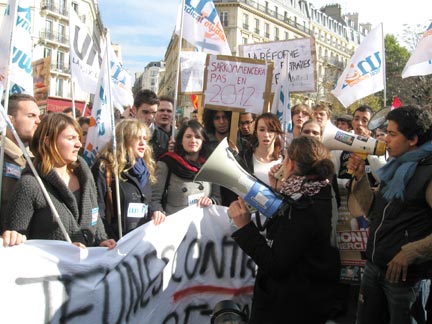 UNEF
activists chanting outside French Senate, October 26. (Internationalist photo)
UNEF
activists chanting outside French Senate, October 26. (Internationalist photo)
In Paris, the march was called for 2:30 p.m. outside the Senate, where the final bill was to be voted after a joint parliamentary committee on Monday merged it with the version passed by the National Assembly. For a long time there were only about 50 students from the UNEF and the FIDL, one of the two unions of high school students, along with another 50 or so demonstrators, surrounded by well over a hundred press photographers, TV cameramen and reporters. A big sign proclaimed: “Students for the Right to Retire at 60.” Another read: “Student at 20, Unemployed at 25, Still Working as a Temp at 67? No Thanks! MOBILIZE!” The chants were mainly about the pension law: “Neither at age 62 nor at 67, we want retirement at 60.” Also: “Retirement at age 60, we fought to win it, we’ll fight to keep it.” And, of course: “Sarkozy, you’re screwed, the youth are in the streets” (Sarkozy, t’es foutu, la jeunesse est dans la rue). They kept this up, chanting and singing, literally non-stop, for at least an hour.
Finally, a march arrived with around 1,000 demonstrators. Banners announced several university campuses: Paris IV, Paris VII. The CGT union federation had a number of locals, from départements 92 and 93 (Paris suburbs), education, rail workers. On the sound truck they were chanting: “They voted for the law, we’re continuing to fight.” A group of women trade unionists sang and chanted, doing some dance steps back and forth, ending up with a charge into the TV cameras. The main chant, repeated over and over, was the single word: “Resistance!”
This underlines the purely defensive character of the movement, and of virtually all the struggles of French workers and youth for the last two decades. In the United States, beginning under Democratic president Jimmy Carter (1976-80) and reaching a crescendo under Republican Ronald Reagan (1980-1988), the capitalists stepped up their war on labor unions at the same time as U.S. imperialism tightened the screws, militarily and economically, on the Soviet Union. Strikes were defeated and unions busted at Greyhound bus lines, Hormel meatpackers, Phelps-Dodge miners, Eastern Airlines and elsewhere. In England, the orgy of union-busting reached a high point as Tory prime minister Maggie Thatcher crushed the 1984-85 coal miners strike.
In France, the bourgeois offensive against workers’ rights really took off after the fall of the bureaucratically degenerated workers state in the Soviet Union and the rest of the Soviet bloc. Counterrevolution in the East demoralized workers in the left-led unions while whetting the bosses’ appetites to keep up with American and British capitalists in increasing profits. While using the 2008 world capitalist economic crisis as an excuse for austerity measures, the attack on workers’ pensions is part of this anti-labor offensive going back years. The first French pension “reform” bill, after all, was in 1995. What’s behind it is that the capitalists want to shore up profits by “capitalizing” (i.e., looting) the trillions of euros locked up in pension systems.
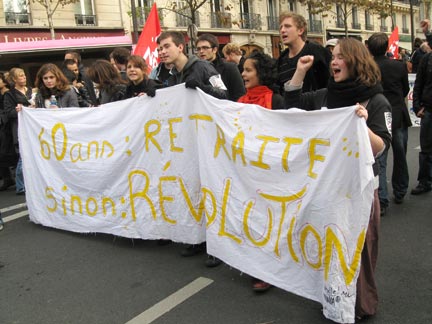 “Age 60: Retirement. Or else:
Revolution.”More likely it will take a fight for revolution to defend
gains now being destroyed by capitalist onslaught. (Internationalist photo)
“Age 60: Retirement. Or else:
Revolution.”More likely it will take a fight for revolution to defend
gains now being destroyed by capitalist onslaught. (Internationalist photo)
Take a look at the figures: the ruling class had no trouble finding €118 billion to bail out the tottering French banks in 2008-09, but now they claim that a projected deficit of €11 billion in the national pension system for 2010 means that ripping up retirement rights is “unavoidable.” They blame the shortfall on longer life expectancy: since workers are not dying fast enough, they must toil longer as wage slaves. However, last year French pension funds (public and private) took in €12 billion in contributions and paid out only €6 billion. So where did the ballyhooed deficit come from? According to an analysis published by Lutte Ouvrière, four-fifths of the deficit was as a result of losses on investments by private pension plans (Lutte de Classes, May 2010)! One popular sticker summed it up: “Le GouverneMENT” (i.e., the government is lying).
At this afternoon’s demonstration, a single banner read: “Age 60: Retirement. Or else: Revolution.” Quite a leap, but if anything it’s the other way around: it will take a revolutionary fight just to ensure workers’ gains, such as retirement rights, now under full-scale assault by the bourgeois rulers. Though the struggle starts out as resistance to attacks on the threadbare “welfare state,” it must go beyond defensive measures to take on the whole capitalist system or be doomed to failure. That is why preparing a real general strike and raising a program of transitional demands leading to socialist revolution are key to waging a successful battle over the pensions law. And that requires fighting the reformism that is undermining this struggle. ■
To contact the Internationalist Group and the League for the Fourth International, send e-mail to: internationalistgroup@msn.com